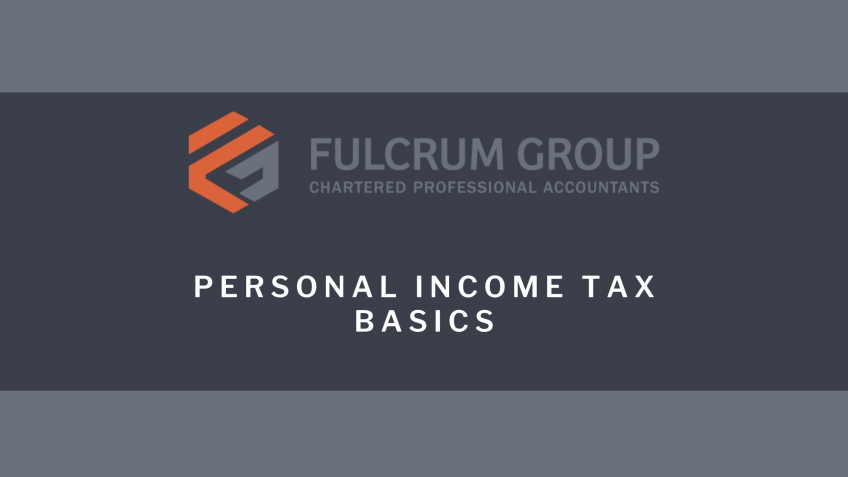Personal Income Tax Basics
With personal tax season quickly approaching, it may be beneficial to review some basic tax concepts to help individuals understand how they are taxed.
In general terms, in Canada, you are taxed on your worldwide income. Deductions, such as RRSPs or childcare expenses can be used to reduce that income prior to taxation. The taxes you owe for a given year will depend on your net income after considering deductions. Finally, credits, such as donations, taxes withheld from your paycheques, tax installments that you made throughout the year, or other credits, can be used to reduce the tax you might owe. If you have already had enough tax withheld from your paycheques or from other tax credits, it is possible you could receive a refund of the taxes you had overpaid during the year. If the taxes withheld from your cheques or other tax credits, is insufficient to cover your taxes, you may end up with a balance owing.
Types of Income
Taxable income in Canada can be summarized into three categories, all of which are taxed differently:
- General income
- This includes income from employment, self-employment, interest income, rental income, government benefits, pensions, etc.
- This income is taxed at the determined marginal rate based on an individual’s income.
- Dividend income
- Split into two types: eligible and ineligible.
- Eligible dividends are those dividends paid from large corporations that do not qualify for the small business deduction. These dividends are taxed at lower rates to an individual as the corporation that paid them paid a higher rate of tax.
- Ineligible dividends are those dividends paid from small corporations that qualify for the small business deduction. These dividends are taxed lower than general income, as the corporation paying the dividend already paid tax before paying these dividends; however, ineligible dividends are taxed higher than eligible dividends as the corporation paying them paid a lower rate of tax.
- Split into two types: eligible and ineligible.
- Capital gains
- This is the income you make by selling investments or other property for more than you originally paid for it.
- If you realize a capital gain, only half of the gain is taxed as a way to encourage investment.
Tax Rates
Canada’s tax system is graduated, which means tax rates increase the higher your income is. Do not let this scare you if you have higher earnings. Your first portion of income is taxed at the low rate, then any additional income above the first tax bracket is taxed at the next rate.
For example, someone that gets a $2,000 raise from $48,000 to $50,000 does not go from paying 25% on the $48,000 to paying 30.5% on the entire $$50,000. Instead, you would pay 25% on the first $49,020 and then 30.5% on the $980 that is above the first bracket.
Below is a table of tax rates in Alberta, courtesy of EY Canada.
The table above only accounts for the basic personal tax credit. Other credits may be available depending on the individual’s income tax situation.
The table above can be useful to determine tax savings on deductions. It also gives an easy visual of the preferred taxation rates available on dividends and capital gains income.
Credits vs. Deductions
Credits and deductions reduce taxes owing for individuals in different ways.
Tax credits reduce the tax you owe on your taxable income. Tax credits are added up and multiplied by the lowest rate of tax (15% Federal and 10% provincial for Alberta) to calculate the amount of taxes that will be reduced. For example, $5,000 of tax credits will reduce the taxes you owe by $1,250 ($5,000*25%). One exception is donation credits over $200, which can reduce taxes owing up to 50%.
There are two types of tax credits: non-refundable and refundable.
- Non-refundable tax credits can only be used to reduce the taxes you owe in the current year. If you have taxes owing of $5,000, but tax credits available of $6,000, the extra $1,000 of tax credits provide no additional benefit and cannot be carried forward. Donations are one exception to this rule that can be carried forward to future years.
- Refundable tax credits can be paid to you even if you have no tax payable. It is rare for tax credits to be refundable. The most common types of refundable tax credits taxpayers qualify for are the GST/HST credit and the Working Income Tax Credit.
Deductions reduce the taxable income of a taxpayer. Deductions benefit high-income earners more because it reduces their income that would be taxed at higher rates. The most common tax deduction is RRSP contributions.
Conclusion
The income tax act is a very large document and tax situations can get complicated quickly. For assistance preparing your personal taxes or questions about what might be required, contact our office.



